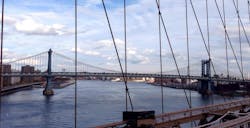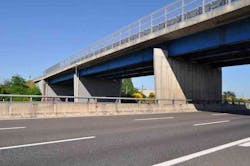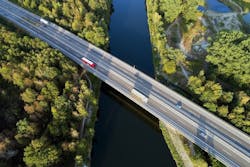Remote bridge health monitoring provides insights into structures
The data is sobering. There are more than 170 million daily crossings on over 45,000 structurally deficient bridges considered to be in poor condition across the country, according to the Federal Highway Administration (FHWA) National Bridge Inventory (NBI).
Structural health monitoring is necessary to extend the life of structures and more importantly, maintain safety for the people who cross bridges daily. Not doing so can be deadly. A recent, catastrophic accident in Mexico City killed at least 24 people, when a beam supporting the railway collapsed. It’s all the more saddening and concerning to hear about accidents like these, in which people were aware of structural issues prior to the accident. We hope that this calls the attention of the public agencies that oversee the safety of bridges and the public and parties involved in bridge maintenance to be more vigilant and proactive when it comes to bridge monitoring, and to react faster to detect and correct the health and stability of such important assets.
Monitoring Critical Bridge Components Using Traditional Methods
In the U.S., most of the bridges are under the responsibility of the Department of Transportation at the state and city level. Traditionally, bridge owners engage in periodic inspections that look at the existing defects. While helpful to assess its current health, this approach does not provide adequate coverage in terms of understanding of the structural stability of the bridge, as it does not work to understand the dynamic behavior of the bridge under load. Additionally, this does not assess if loads of traffic are inducing stress above the limits that the structure has been designed for. This approach is much more reactive, compared to proactively preventing defects to occur.
Remotely Monitoring The Health And Structure Stability To Maintain Infrastructure Safety
Remote health monitoring technology is a major innovation in the field of bridge monitoring, as it does much more than simply study traffic over a structure. Today, thanks to structural health monitoring, we are able to determine the impact of a bridge's operations on its state of structural health, so that owners and operators can improve its management and ensure user safety. Remote monitoring has been around for several years and it has continued to evolve into an integrated solution that is able to monitor a bridge 24/7. This technology ensures that each bridge can support the type of dynamic loads that it is subjected to, such as trucks or trains moving heavy loads over it, enforces the limits of loads for which the bridge has been designed for, and also estimates with increased traffic and current profile of loads the remaining life span of the bridge.
By installing remote monitoring devices in bridges, operators and owners can uncover early and critical insights into the structures and understand the behavior of bridges. With this information, they can more confidently allocate funds accordingly to make repairs and reinforcements where it is necessary to ensure public safety.
How It Works
By using optic fiber-based sensors, the solution continuously measures the behavior of bridges and turns that data into knowledge for decision-making via a user-friendly dashboard, to assess the health. The data shows the stability index for each bridge and alerts operators when load conditions induce stress above the defined threshold levels. Abnormal conditions can also be monitored from a global monitoring center for added peace of mind.
The system monitors a wide range of structural stresses resulting from damage over time due to aging, traffic and heavy loads, subsoil movements, nearby operations and work, and climatic and seismic events. With this technology, the prioritization and optimization of the inspection and maintenance operations is driven by continuous on-field real-time monitoring.
A Quantitative Approach To Fund Allocation
By using remote monitoring technology, bridge operators and owners with multiple bridges can quickly assess the level of health and structural stability of each bridge and allocate funds accordingly. Equipped with this technology and data, owners can take a quantitative approach—instead of just a qualitative one—to address the necessary impacts based on data-shaped insight.
This is particularly important for bridges that are either past or close to the design life spans, and bridges that are being used above the design work loads, as current needs of transportation vary greatly from when they were designed and built 50 years ago.
Safer Transportation for The Public
There are more than 617,000 bridges across the United States; 7.5% of these bridges are considered structurally deficient—in “poor” condition. Unfortunately, 178 million trips are taken across these structurally deficient bridges every day, based on the latest data from ASCE’s 2021 Report Card for America’s Infrastructure.
Remote monitoring equips operators and owners with a powerful tool to help them make decisions that reduce the risk to the public that is using these bridges. The system detects structural issues prior to structural failure. By being informed, the structures can be proactively reinforced, and the public can be preemptively evacuated, if required.
Optimizing Maintenance Strategies
Quantitative data helps ensure the most critical work is being prioritized to maintain safety. Visual damage or other circumstances can induce possible unnecessary work and distract from more important repairs. For example, cracks can stem from several causes, including differential settlements, corrosion, excessive loadings, material aging, and important thermal variations. Now, decisions can be based on real structural information and not just mere visual clues.
It is time to transition from a traditional schedule-based maintenance system to a condition-based maintenance strategy. All bridge conditions are different, with varying traffic, loads, weather and environmental conditions, and other nuances. Driven by data, remote monitoring seamlessly adapts the maintenance policy to each asset.
Reducing Costs For Operators And Taxpayers
Our infrastructure is aging, in fact, 42% of all bridges are at least 50 years old and the FHWA estimates that it will cost $125 billion to address the backlog for repairs of existing bridges. When operators and owners are able to understand the level of health of the bridges, they can allocate funds where they are needed. In addition, they can more accurately equate the remaining life of the bridge and ensure that future budgets take into consideration the bridges that will need replacement.
These important insights help extend the lives of structures, while ensuring user safety, to save natural resources and reduce costs. Improved bridge management also ensures that taxpayer’s money is used where it is needed.
Extending The Asset Service Life, While Avoiding Emergency Management
With consistent structural health monitoring, owners and operators can define the appropriate maintenance actions needed to properly maintain the asset. In addition, they can adapt the bridge’s level of service, to promote a longer service life. This helps ensure bridges are in good working order and are available for use by the public.
When done correctly, teams can extend the asset service life safely, without risking abrupt closures and costly urgent responses due to failures. This also avoids the substantial expenses associated with protective measures.
Restoring Bridge Safety
In addition to utilizing remote monitoring technology, bridge operators should take it a step further by conducting additional inspections around troublesome areas. They can consider working with a third-party expert to find solutions to address the issues detected and ensure that repairs comply with the construction code. Ultimately this will return the bridge to an acceptable safe condition for the traveling public.
Remote Monitoring In Action
Over 50 years ago, the Silver Bridge over the Ohio River collapsed due to a 0.1-in. defect in one of the structure’s metal bars and poor maintenance. The accident plunged 32 vehicles into the freezing water and is one of the deadliest U.S. bridge collapses, to date. Thankfully, with modern remote monitoring technology, we are able to accurately monitor infrastructure health and improve maintenance to avoid fatal events like these.
Let us take a closer look at how this technology is being used today, with a real-life example. A three span bridge, owned and operated by a major highway concessionaire, resides over a major highway and high-speed railway and is often used for scheduled exceptional convoys. The challenge was to implement multiple solutions: structural health monitoring, vehicle weight monitoring, and life cycle and fatigue analyses, in order to mitigate risk and avoid any potential deterioration in safety and performance.
In this case, the team implemented a data acquisition system with optical strands (24 sensors), cameras for plate recognition, and innovative algorithms for temperature correction and counting and weighing of vehicles. This resulted in user safety, knowledge, and eventual control of overweight vehicles, and condition-based maintenance and repair.
Remote Monitoring Adoption On The Rise As Bridge Design End Of Life Approaches Nationally
Remote bridge monitoring has made a significant breakthrough into the field in the last decade, having historically been used as a research and development tool. Its benefits are coming to realization, especially in the U.S., as the number of bridges approaching the design end of life is increasing rapidly as well as the ones that are already past it.
To reduce the risk for the public and environment, we need to start acting today to monitor those bridges for both short- and long-term impacts. An ASCE study highlights that the U.S. is spending only half of what it needs to invest in infrastructure improvements just to bring systems up to par, projecting an infrastructure funding shortfall of $2.59 trillion over the next 10 years. A reallocation of funds is critical so a greater investment in remote monitoring can be made to this fundamental infrastructure that keeps America moving.
Biden’s expansive $2 trillion infrastructure plan aims to combat decades of disinvestment in this area, bringing hope as it promises to fix 10,000 crumbling bridges. But with 220,000 U.S. bridges needing repair work, and 79,500 needing replacement, cost-effective, scalable, efficient solutions such as remote monitoring are an essential part of the solution to extend the life of structures and maintain safety.


